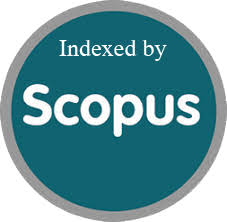Theoretical Stress Analysis of Gas Turbine Blade Made From Different Alloys
Abstract
Blades may be considered to be the heart of turbine without blade there would be no power and the slightest fault in blade would mean a reduction in efficiency and costly repairs.The centrifugal force is one of the problems faced by the designer of blades especially at the first stages. The designer aims at reducing the stresses with in the allowed limit.The ANSYS 15 software was used as far as it is the most effective in analyzing the different numerous cases of stresses, the blades with limited root in all direction (X,Y,Z) were taken into consideration . The centrifugal forces were applied on the rotor blades at running speed of 6000 r.p.m., The finite element models of the blade were constructed using D3-10-noded Tetrahedron elements shape, SOLID 187, mesh of the entire blade 23406 Node,136575element. The average of normal stress, Von misses, Maximum principle stress, Minimum principle stress were calculated according to ANSYS 15 program, these stresses are as the result of the effect of centrifugal force for all planes along the blades and then values of stresses were compared to the curves for each alloy.The current research concluded that the Titanium alloy is the best alloy used in terms of reducing stresses due to centrifugal force, that is because density of Titanium alloy used is less than that of other used alloys, leading a reduction in centrifugal forcess that are directly proportional to mass.
References
- Ajit Prasad, K.Ramachandra, M.Pradeepand K.Kumar"Effect Of Rubbing Forces Due To Centrifugal Loading On Rotor Blades"(2004).
- SK Bhatti S Chandra Prasad D Radha Krishna IN Niranjan Kumar BVARao"LIFE EVALUATION METHOD FOR GAS TURBINE BLADES MADE OF INCONEL718 ALLOY" Proceedings of the 2nd WSEAS Int. Conference on Applied and Theoretical Mechanics, Venice, Italy,208, November( 20-22, 2006).
- Mats Eskner "Mechanical Behavior of Gas Turbine Coatings" Royal Institute of Technology,Stockholm (2004).
- R.A. CLUDIO, C.M. BRANCO, E.C. GOMES, J. BYRNE" LIFE PREDICTION OF A GAS TURBINE DISC USING THE FINITE ELEMENT METHOD" 8AS JORNADAS DE FRACTURA,(2002).
- AHMED ABDULHUSSEIN JABBAR1, A. K. RAI2, P. RAVINDER REEDY" DESIGN AND ANALYSIS OF GAS TURBINE ROTOR BLADE USINGFINITE ELEMENT METHOD"International Journal of Mechanical and Production,ISSN(P): 2249-6890; ISSN(E): 2249-8001, Vol. 4,73-94, Issue 1, Feb (2014).
- P.V.Krishnakanth1, G.Narasa Raju2, R D V. Prasad3, R. Saisrinu4 ," Structural & Thermal Analysis of Gas Turbine Blade by Using F.E.M" International Journal of Scientific Research Engineering & Technology (IJSRET), Volume 2 Issue2 pp 060-065, ISSN 2278 0882,May (2013).
- Help of ANSYS program V (15.0),(2016).
- Theju V,Uday PS,PLV Gopinath Reddy,C.J. Manjunath, Design and Analysis of Gas Turbine Blade, International Journal of Innovative Research in Science, Engineering and Technology, ISSN: 2319-8753,June,(2014).
- V.NagaBushanaRao,N.Niranjan Kumar,N.Madhulata,A.Abhijeet,Mechanical Analysis Of 1st Stage Marine Gas Turbine Blade,International Journal Of AdvancedScience and andTechnology,pp.57-64, vol.68,(2014).
- REFERENCES








